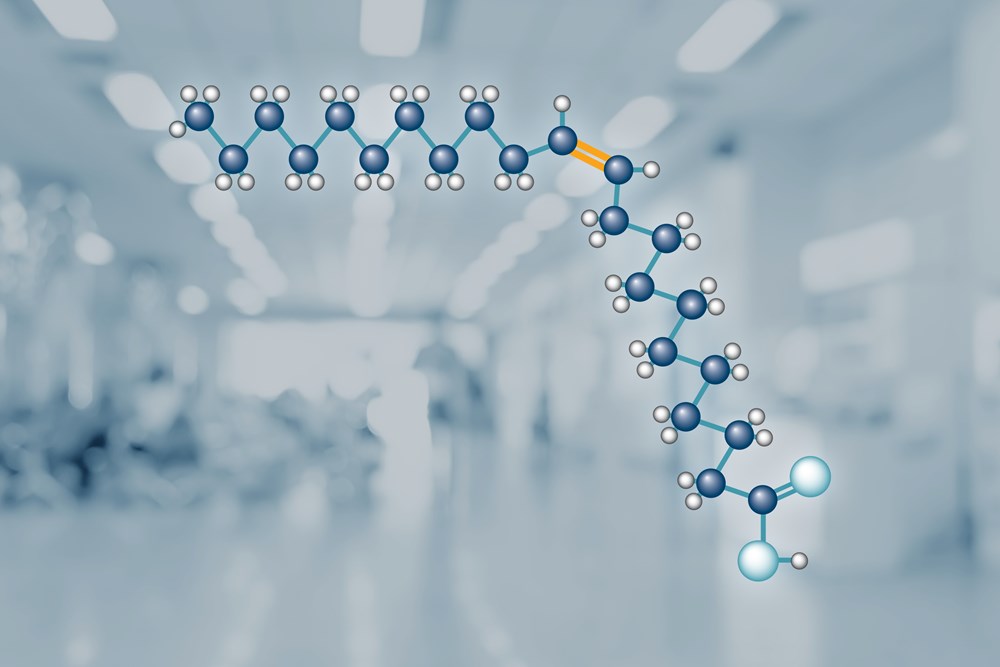Epax® NovusLipid
Beyond Omega-3: EPAX® Omega 3-9-11
The North Atlantic Ocean is home to pelagic fish with a unique composition of fatty acids. Unlike fish in warmer waters, these fish boast a healthy amount of the long-chain polyunsaturated Omega-3 fatty acids, plus an unusually high content of long-chain monounsaturated fatty acids (LC-MUFA); Omegas 9 and 11.
Applying our gentle and targeted distillation process Epax® EQP+Tech, we have been able to isolate and increase the content of both the well-known Omega-3s EPA (C20:5 n-3), and DHA (C22:6 n-3) as well as the less well known LC-MUFAs Omega-9 gondoic acid (C20:1 n-9) and Omega-11 cetoleic acid (C22:1 n-11). In total these fatty acids make up a minimum of 720mg/g of EPAX® Omega 3-9-11.
Skin health is one of the key areas of interest for EPAX® Omega 3-9-11. EPA and DHA supplementation has been shown to reduce skin inflammation and there is a history of LC-MUFA involvement in skin and anti-inflammatory effect of cetoleic and gondoic acid [1].
In a double-blind, placebo-controlled study, Epax oils with cetoleic acid improved skin redness (marker of inflammation) compared to placebo [2]. This laid the foundation for the design of a study of the effect of LC-MUFA on eczema (an inflammatory skin condition). Recruitment for this trial began in December 2023.
Another way cetoleic acid might influence the body is through increased conversion of ALA to EPA and DHA. This has been shown in canine cultured liver cells in an Epax study and an independent study of human liver cells [3]. This is further supported by human studies showing a higher Omega-3 index than would be expected in oils containing LC-MUFA.
Preclinical research with LC-MUFA oils has largely focused on the role of these oils in metabolic health. Beneficial effects, complementary to EPA and DHA were seen on LDL cholesterol in animal models and humans [4].
Omega 3-9-11, brings together the health benefits of mono- and polyunsaturated fatty acids, the best of both worlds.
EPA and DHA are the backbone of healthy nutrition with over 40,000 research articles. Omega-9 and omega-11 LCMUFAs are emerging as anti-inflammatory molecules with effects on adipose tissue biology. Together they can exert greater effect than alone [5]. Therefore, EPAX Omega-3-9-11 is a combination of bioactive lipids brought together to promote better health.
All EPAX® oils are produced to the highest quality standards, in a facility approved by US FDA for manufacture of Pharmaceutical Intermediates and approved by the Norwegian Medicines Agency for manufacture of Active Pharmaceutical Ingredients (API).

References
1. Yang, Z.H., et al., Pollock oil supplementation modulates hyperlipidemia and ameliorates hepatic steatosis in mice fed a high-fat diet. Lipids Health Dis, 2011. 10: p. 189.
2. Mildenberger J, M.L., Optihud: A nutritional, single centre, placebo controlled, randomised, blinded study of the effect of mackerel oil on skin quality and omega-3 index. 2022, Møreforsking.
3. Østbye, T.K., et al., The long-chain monounsaturated cetoleic acid improves the efficiency of the n-3 fatty acid metabolic pathway in Atlantic salmon and human HepG2 cells. Br J Nutr, 2019. 122(7): p. 755-768.
4. Yang, Z.H., et al., Supplementation with saury oil, a fish oil high in omega-11 monounsaturated fatty acids, improves plasma lipids in healthy subjects. J Clin Lipidol, 2020. 14(1): p. 53-65.e2.
5. Yang, Z.H., et al., Long-term dietary supplementation with saury oil attenuates metabolic abnormalities in mice fed a high-fat diet: combined beneficial effect of omega-3 fatty acids and long-chain monounsaturated fatty acids. Lipids Health Dis, 2015. 14: p. 155.
